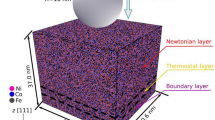Abstract
The effect of the test temperature on the mechanical behavior of a titanium nickelide–based alloy is considered. The behavior of a titanium nickelide–based alloy is shown to be substantially dependent on the level of stresses and strains of the material. The critical stresses are determined by the solid-solution, grain-boundary, strain, and precipitation hardening mechanisms. The maximum critical strain can be achieved by a combination of several hardening mechanisms.




Similar content being viewed by others
REFERENCES
A. A. Il’in, M. Yu. Kollerov, I. S. Golovin, and A. A. Shinaev, “Mechanisms of forming during deformation and heating of titanium shape memory alloys,” Metalloved. Term. Obrab. Met., No. 4, 12–16 (1998).
M. Yu. Kollerov, D. E. Gusev, A. V. Burnaev, and A. A. Sharonov, “Effect of the chemical composition and the structure on the thermomechanical behavior of titanium nickelide-based alloys,” Metalloved. Term. Obrab. Met., No. 6 (744), 38–44 (2017).
Shape Memory Materials, Ed. by Otsuka and C. M. Wayman (Cambridge University Press, Cambridge, 1998).
S. A. Shabolovskaya, “Surface, corrosion, and biocompatibility aspects of nitinol as an implant material,” Bio-Med. Mater. Eng., No. 12, 69–109 (2002).
M. Yu. Kollerov, D. E. Gusev, and A. V. Burnaev, “Regularities of forming of titanium nickelide-based alloys during mechanical and thermal actions,” in Challenging Problems of Strength (VGTU, Vitebsk, 2018), Vol. 1, pp. 141–160.
K. Otsuka and X. Ren, “Physical metallurgy of Ti–Ni-based shape memory allous,” Progr. Mater. Sci., No. 5 (50), 511–678 (2005).
K. Ootsuka, K. Simidzu, Yu. Sudzuki, et al., Shape Memory Alloys, Ed. by Kh. Funakubo (Metallurgiya, Moscow, 1990).
V. N. Khachin, V. G. Pushin, and V. V. Kondrat’ev, Titanium Nickelide (Nauka, Moscow, 1992).
M. Kollerov, E. Lukina, D. Gusev, P. Mason, and P. Wagstaff, “Impact of material structure on the fatigue behavior of NiTi leading to a modified Coffin–Manson equation,” Mater. Sci. Eng. A 585, 356–362 (2013).
J. Frensel, E. P. George, A. Dlouhy, Ch. Somsen, M. F.-X. Wagner, and G. Eggeler, “Influence of Ni on martensitic phase transformations in NiTi shape memory alloys,” Acta Materialia 58 (9), 3444–3458 (2010).
V. A. Lobodyuk and E. I. Estrin, Martrensitic Transformations (Fizmatlit, Moscow, 2009).
M. Yu. Kollerov and A. A. Il’in, “Features of fabricating and applying of bio- and mechanically compatible implants made of titanium nickelide,” Titan, No. 1, 47–54 (2018).
V. E. Gyunter, V. N. Khodorenko, Yu. F. Yasenchuk, et al., Titanium Nickelide, Next-Generation Medicine Material (MITs, Tomsk, 2006).
A. A. Il’in, Mechanism and Kinetics of Phase and Structural Transformations in Titanium Alloys (Nauka, Moscow, 1994).
J. Bernardini, C. Lexcellent, L. Daroczi, and D. L. Beke, “Ni diffusion in near-equiatomic Ni–Ti and Ni–Ti(–Cu) alloys,” Phil. Mag. 83 (3), 329–338 (2003).
D. Liu, J. Fiebig, M. Peterlechner, S. Trubel, M. Wegner, Y. Du, Z. Jin, G. Wilde, and S. Divinski, “Ti and Ni grain-boundary diffusion in B2 NiTi compound,” Defect Diffus. Forum 363, 137–141 (2015).
M. I. Goldstein, S. V. Grachev, and Yu. G. Veksler, Special Steels: Tutorial (Metallurgiya, Moscow, 1985).
D. E. Gusev, M. Yu. Kollerov, and A. A. Popov, “Effect of volume fraction of Ti2Ni and aging on the structure and properties of titanium nickelide-based alloys,” Metalloved. Term. Obrab. Met., No. 2 (752), 14–21 (2018).
ACKNOWLEDGMENTS
This work was performed on the equipment of the Resource Collective Use Center “Aerospace Materials and Technologies” of the Moscow Aviation Institute.
Funding
This work was carried out in the framework of state assignment to institutes of higher education no. 11.7449.2017/64.
Author information
Authors and Affiliations
Corresponding author
Additional information
Translated by Yu. Ryzhkov
Rights and permissions
About this article
Cite this article
Kollerov, M.Y., Gusev, D.E., Afonina, M.B. et al. Effect of Structure on the Critical Stresses and Strains in Titanium Nickelide-Based Alloys. Russ. Metall. 2020, 760–766 (2020). https://doi.org/10.1134/S0036029520070095
Received:
Revised:
Accepted:
Published:
Issue Date:
DOI: https://doi.org/10.1134/S0036029520070095




